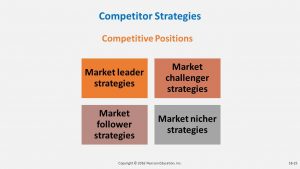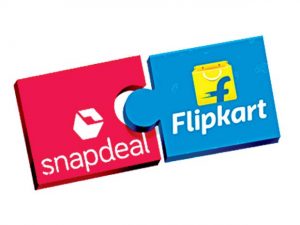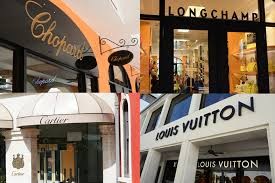Based upon the market share, each company enjoys one of these positions:
Dominant: A firm is in a dominant position, has control over other competitors. Dominance in the market gives a firm chance to enjoy more freedom to select suitable strategic options.
Strong: A strong firm doesn’t control behaviour of other competitors, but c an take independent actions without jeopardizing its long-term position. But, other competitors’ actions do not have a notable impact on its position.
an take independent actions without jeopardizing its long-term position. But, other competitors’ actions do not have a notable impact on its position.
Favorable: These firms are in position to exploit opportunities to improve their positions. They need to constantly adjust their strategies to continue enjoying the better-than-average opportunities for which they have to remain alert and struggle constantly.
Tenable (Average): These firms have satisfactory performance, but they suffer due to dominant and strong competitors. These firms have less-than-average opportunities to improve their positions.
Weak: Weak firms have unsatisfactory performance. However, they need to keep a watch on opportunities to improve their positions. Weak firms must change or adjust constantly to exist.
Nonviable (non-survivable): Such firms have unsatisfactory performance and have no opportunity to improve their performance and position.
Depending on the position of firms in market, there are four types of market dominance strategies. These are market leader, market challenger, market follower, and market nicher.
Market leader: Market leader has the largest market share in the relevant product in the industry. It has a dominant position in the market. Obviously, it leads in new product development, price change, distribution coverage, promotional activities, and novel experiments. The leader may or may not be respected by other firms, but other firms have to acknowledge its dominance. Other firms can challenge, follow or avoid the market leader. In India, well-known market leaders are Maruti Suzuki in cars, Hero Honda in two-wheelers, TCS in Information Technology, HDFC in Banking, Hindustan Unilever in consumer goods, Coca-Cola in soft-drink, McDonald’s in fast food, Life Insurance Corporation in life-insurance etc.
A few market leaders enjoy monopoly in the market. They need to remain alert all the time for maintaining their leadership position. Other firms constantly challenge leadership position. A little mistake here and there can force the leader into second or third position. It has to adopt innovative practices in all the marketing areas. Sometimes, it has to incur excessive costs to maintain the number-one position.
A leader position firm which desires to maintain market- leader position has to adopt one or more strategies such as Expanding Total Market, Defending Current Market Share and Expanding Certain Segment Market Share. To remain a leader the firm needs to remain alert in market.
Market challenger: Market challengers are known as runner-up firms. They occupy second, third or lower ranks in an industry. Bajaj Auto in two-wheelers, Tata Motors and Hyundai in cars, Reliance Petro and Essar Oils in refineries challenging ONGC, Pepsi-Cola in soft-drink, Procter and Gamble in consumer goods, Vodafone in cellular service providers, Sony and Samsung in cell-phone instruments, etc., are some of the market challengers in India.
Market challengers are capable to attack the leader and other competitors. Sometimes, capable challengers can overtake the leader. Market challengers also target smaller, more vulnerable competitors. The fundamental principles involved are: to assess the strength of the target competitor, keep searching opportunities to attack the target, to keep a watch on the amount of support that the target might muster from allies. Challengers usually choose only one target at a time. Challengers prefer to attack the target at a vulnerable moment. Challengers usually launch the attack on narrow front.
Usually challengers adapt these strategies: price discounts or price cutting, line extensions, introduce new products, reduce product quality to cut on costs, increase product quality, improve services, change distribution strategies and intensify promotional activity.
Market follower: These firms prefer to follow leader rather than to use new strategies and waste energy and resources. They do not face the leader directly. Some followers are capable to challenge but they prefer to follow. However, market followers always react strongly in case of any loss. In some capital goods industries like steel, cement, chemical, fertilizer, etc., product differentiation is low, service qualities are similar, and price sensitivity is high. They decide to provide similar offers by copying the market leader. But, one glaring fact is that followership is not always satisfying path to pursue.
Market followers prefer to follow the leader doesn’t mean that they don’t require specific market strategies. They cannot be simply passive or simply carbon copy strategies adopted by leaders. They need to hold current customers and win a fair share of new customers. Followers usually keep manufacturing cost low and offer better quality products with satisfactory services. At the same time, they do enter new markets as and when there are opportunities. Market followers are bound to exist in a mature market. The market followers are wider in case of online marketing because online marketing has lower entry barriers and higher returns. Thus, in online commerce itself, you will see that companies like Snapdeal, Flipkart, Jabongg have all started one after the other. Off course, the market leaders were Ebay and Amazon. And, today e-Bay and Amazon are facing tough competition.
It is a simple way to follow the leader. The follower who wants to be imitator duplicates the leader’s product as well as package and sells it in the market through disrepute distributors. Products are marketed secretly to avoid legal complications. The product seems exactly similar to original product except basic quality and features. This is common strategy in auto-parts and electronics products. People, knowingly or unknowingly, buy such duplicate products as they are made available at low price.
They can also me Emulators. The emulator clones (emulates) the leader’s products, distribution, advertising and other aspects. Here, product and packaging may be identical that of leader, but brand name is slightly different. Market is full of cloned products especially in interiors of the country. You will find bottled water with labels of Bisleri, Aquafina; toothpaste tubes with Colgate, Cibaca labels but then the packaging is of inferior quality. This strategy is widely practiced in computer business also. The cloned products are openly sold in the market because of fake practices. The fake brands are pushed in the distribution of firms.
Market specialist or nicher: A niche is a more narrowly defined small market (limited number of buyers) whose needs are not being well-served by existing sellers. It is a small segment that has distinctive needs and is, mostly, ready to pay high price. Marketers can identify niches by dividing a segment into sub-segments or by dividing a group with a distinctive set of traits.
They may seek a special combination of benefits. Niches (small groups of buyers) are fairly small and normally attract a few competing firms. A nicher is the small firm serving only small specific groups of customers. The firm’s marketing efforts to serve the niches successfully is called nichemanship.
Nichers understand their niches’ needs so well and minutely that their customers are willing to pay a premium price. They design special products with distinctive features, qualities, uses, and value for special group which are tailor-made to suit the buyer’s needs. Nichers have special skills to serve their market in luxury goods segment and fashion industry. They gain certain economies through specialization. Nichemanship strategy is also called focus strategy. The objective is focusing marketing efforts on one or few narrow market segments and tailoring the marketing mix to give those chosen customers tailored offer. The firm typically looks to gain a competitive advantage through effectiveness. The most successful nichers tend to have the following characteristics:
- They tend to be in high value (luxury goods) industries and are able to obtain high margins.
- They tend to be highly focused on a specific market segment.
- They usually market high end products and are able to use a premium pricing strategy.
Conclusion: Today, the market scenario is so susceptible to the environmental vulnerability that many companies live a very short lifecycle. The acronym VUCA has shaken the world. Political, economical, social, technological, legal and environmental parameters in the world have become Volatile, Uncertain, Complex and Ambiguous than ever before. Therefore, no company can take its position in market for granted. Though for many people the term VUCA is linked to negativity, but, a new wave of thinking shows that embracing vulnerability is actually crucial for sustainability of businesses.
















































